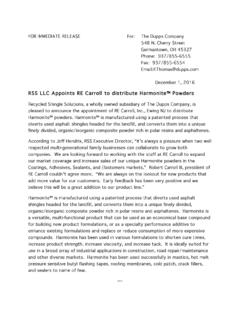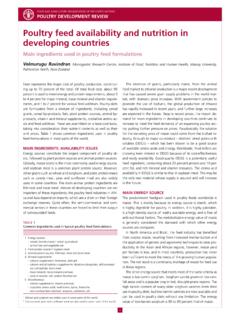Transcription of FEEDING ORGANIC PIGS - britishpigs.org.uk
1 FEEDING ORGANIC pigs . A HANDBOOK OF RAW MATERIALS AND. RECOMMENDATIONS FOR FEEDING PRACTICE. Produced by: Professor Sandra Edwards School of Agriculture Food & Rural Development University of Newcastle Newcastle upon Tyne NE1 7RU. Publication Date: June 2002. ISBN: 0 7017 0131 5. 1. FEEDING ORGANIC pigs . A handbook produced by University of Newcastle As part of a collaborative project involving ADAS Consulting Ltd Eastbrook Farms Eco-Stopes Consultancy Funded by DEFRA. with contributions from Tesco and Pig Improvement Company Ltd This handbook is intended to be a guide only.
2 Whilst the information it contains is believed to be correct, it is not a substitute for appropriate formal advice. The University of Newcastle can take no responsibility for actions taken based on the information contained in this handbook. 1. CONTENTS. Section Page Introduction 4. ORGANIC Standards for FEEDING of pigs 5. Formulating pig diets 7. General considerations in FEEDING different categories of pigs 9. Diet specifications for pigs 13. Feedstuffs compendium 16. Cereals Barley 17. Wheat 18. Oats 19. Rye 20.
3 Triticale 21. Maize 22. Protein sources Full fat soya 23. Soya bean meal 24. Full fat rapeseed 25. Rapeseed meal 26. Beans 27. Peas 28. Lupins 29. Fishmeal 30. By-products Wheatfeed 31. Wheat bran 32. Maize gluten feed 33. Dried sugar beet pulp 34. Molasses 35. Wet sugar beet pulp 36. Brewers grains 37. Whole milk 38. Skim milk 39. Whey 40. 2. Root crops Potatoes 41. Fodder beet 42. Carrots 43. Swedes 44. Parsnips 45. Turnips 46. Sugar beet 47. Grass and silage Fresh grass/clover 48. Grass/clover silage 49. Lucerne silage 50.
4 Whole crop silage 51. Maize silage 52. Green vegetable waste 53. Grassmeal 54. Dried lucerne 55. Appendix A. Feedstuffs permitted under EU regulations for ORGANIC livestock production 56. 3. Introduction In the FEEDING of pigs , the main objective is to produce piglets from breeding animals, and subsequently meat from those piglets, with the maximum efficiency and profitability. Since feed accounts for 70-80% of the cost of pigmeat production, the correct formulation and rationing of feed is critical to this process.
5 In conventional production, there has been a great deal of research into the nutrient requirements of pigs and the FEEDING value of the commonly available raw materials, and diet formulation and FEEDING strategies have become extremely sophisticated. In ORGANIC pig production, considerations other than simple economic efficiency of production come into play. ORGANIC farming requires an integrated, whole-farm approach to food production which takes due account of sustainability, environmental and animal welfare considerations.
6 Thus, whilst much of the knowledge gained from conventional pig production can be applied in the ORGANIC context, the FEEDING of ORGANIC pigs will differ from that of conventional pigs in a number of significant ways. This handbook is designed to assist the ORGANIC pig producer in selecting appropriate diets and FEEDING strategies by summarising the relevant knowledge from conventional pig nutrition, discussing the ways in which ORGANIC systems may differ, presenting simple rules for diet formulation and providing information on the nutritional value and FEEDING characteristics of different raw materials for ORGANIC pig diets.
7 This information will not be comprehensive, since good data specifically collected on ORGANIC pig nutrition are still very sparse, but should provide an adequate grounding for the FEEDING of pigs of all classes under ORGANIC conditions within the United Kingdom. 4. ORGANIC Standards for FEEDING of pigs For any farm to sell ORGANIC produce, it must (according to EC Regulation 2092/91) be registered with a recognised Certification Body and adhere to the standards specified by that body. Within the UK, a number of such Certification Bodies are accredited and approved by the UK government authority, the United Kingdom Register of ORGANIC Food Standards (UKROFS).
8 These Certification Bodies currently include: Soil Association Certification Ltd. ORGANIC Farmers and Growers Ltd Scottish ORGANIC Producers Association Bio-Dynamic Agricultural Association ORGANIC Food Federation Irish ORGANIC Farmers and Growers Association ORGANIC Trust Ltd CMi Certification Each Certification Body can formulate and inspect to it's own standards, and there are minor differences between the different bodies. It is therefore essential to check the detailed standards of the body with which the farm is certified before finalising the FEEDING strategies for pigs produced on that farm.
9 However, in 1999, the European Union produced harmonised standards for ORGANIC livestock production, which provide the baseline to which all member states must conform (EC Regulation 1804/99 supplementing the basic Regulation 2092/91). It is these standards, subsequently adopted by UKROFS, which are outlined in the following section. It is important to be aware that whilst these standards must always be adhered to, more stringent rules with additional requirements regarding feedstuffs and FEEDING may be applied by individual certification bodies.
10 In all cases, ORGANIC pigs can only be fed on food predominantly produced under certified ORGANIC conditions. General livestock production standards affecting FEEDING strategy Feed is intended to ensure quality production rather than maximising production. Preference is to be given to indigenous breeds and strains of pig All pigs must have access to pasturage or an open-air exercise area or an open-air run which may be partially covered, and they must be able to use those areas whenever the physiological condition of the animal, the weather conditions and the state of the ground permit.





